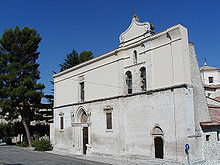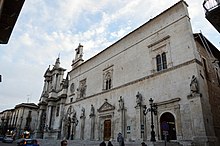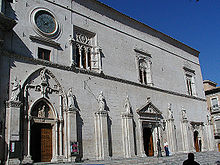Sulmona
| Sulmona | ||
|---|---|---|

|
|
|
| Country | Italy | |
| region | Abruzzo | |
| province | L'Aquila (AQ) | |
| Coordinates | 42 ° 2 ' N , 13 ° 56' E | |
| height | 405 m slm | |
| surface | 58 km² | |
| Residents | 23,326 (Dec. 31, 2019) | |
| Population density | 402 inhabitants / km² | |
| Post Code | 67039 | |
| prefix | 0864 | |
| ISTAT number | 066098 | |
| Popular name | Sulmonesi or Sulmontini | |
| Patron saint | Pamphilus | |
| Website | Sulmona | |
 Sulmona in the valley |
||
Sulmona is an Italian city in the province of L'Aquila in the Abruzzo region .
Location and dates
The city has 23,326 inhabitants (as of December 31, 2019) and is located in a wide valley in the middle of Abruzzo, which is surrounded by the highest mountains of the Apennine chain. Sulmona is on the edge of the Maiella National Park .
history
In ancient times the city was called Sulmo and belonged to the Paeligner territory . The name could come from sulmo = rich in water. When it was integrated into the Roman Republic , Sulmo became a municipality . It was destroyed by Sulla during the civil wars but rebuilt. The poet Ovid came from Sulmo, who repeatedly commemorated his homeland in his works ( Tristien 4, 10, 3: Sulmo mihi patria est gelidis uberrimus undis - "my homeland is Sulmo, abundant in cold waters"). This is where the initials “SMPE” come from in the city's coat of arms ( S ulmo m ihi p atria e st).
Frederick II favored the city after it had stood by him against the papal troops, so that Sulmona particularly flourished during the Staufer period and became the capital of the country. During this time it was the seat of one of the seven annual fairs of the empire, the court district of Abruzzo and the seat of a chair for canon law . This development ended when Charles II of Anjou made L'Aquila his residence.
See also: Prince of Sulmona
At the time of the Anjou and the Aragonese , Sulmona was an efficient handicraft and trading center, especially for goldsmithing . Sulmona is the hometown of the humanists Barbato, Quatrario, Ercole Ciofano and of Pope Innocent VII.
In the old town center within the wall belt with well-preserved city gates are most of the city's structures that have been preserved or restored.
Although numerous earthquakes affected the city, in addition to the dominating churches, in hidden courtyards, small old open staircases, recessed stairs, coats of arms and capitals, small porticoed halls and fountains carved in stone can be discovered. The city was affected by the earthquake in Abruzzo on November 3, 1706. In total, the quake caused more than a thousand deaths in the affected area.
Attractions
San Panfilo Cathedral
The church was built in the 8th century and changed significantly in the 11th and 12th centuries. The apse , the double column row and the crypt date from the Romanesque period . The facade was built in two phases, the lower part in the 14th century (main portal 1391 by Nicola di Salvitti), the upper part in 1706. In that year the cathedral was badly damaged by earthquakes. The campanile was built in 1751. The remains of some frescoes from the 15th century, the sarcophagus of Bishop Bartolomeo de Petrinis from 1422, the wooden crucifix from the 14th century, the marble mosaics and the choir stalls are worth seeing . Other wooden church utensils by Ferdinando Mosca da Pescocostanzo from the 18th century as well as a bishop's chair located in the crypt, a stone sculpture with the Virgin and Child Jesus, a fresco from the 14th century and in the arcosolium of an ancient tomb, some gravestones, a marble edicula from the 17th century containing the silver bust of the patron saint (a work by Giovanni di Marino) from 1459 are further gems. A rich archive can also be seen in the sacristies .
The Church of San Gaetano
On the ruins of an older Roman building with mosaics from the 1st century, the old church of Santa Maria was built in the High Middle Ages. Despite the simplicity of its external structures, it reveals an extraordinary number of archaeological remains inside. They show the different phases of the Christian house of God in chronological order.
Palazzo Sanita
The wealthy Sanita family moved from Todi to Sulmona in the first half of the 13th century. The remains of the formerly magnificent palazzo are today a portal in the style of Durazzi, the remains of double-arched windows, the inner courtyard, the staircase leading to the upper floors and the valuable Virgin Mary with the baby Jesus painted by Andrea Delitio around the middle of the 15th century.
Palazzo Tabassi
The Palazzo Tabassi is, like the already mentioned Palazzo Sanita, a typical, late medieval aristocratic residence with a small inner courtyard and an impressive, two-arched window. It also has a Durazzi-style portal, made in 1449 by the master Petro da Corno. A special feature is that there is a Roman tombstone with a hunting scene on the left angle iron.
Palazzo dell'Annunziata and Chiesa della Santa Annunziata
Both structures belong together architecturally. Seen from the front, the church is the building on the left.
The city's publications refer to the Palazzo Santissima Annunziata as "the most precious jewel of the city's architectural wealth". The building, which was built from 1413 onwards and has been modified again and again, was expanded to its present form in the late 16th century. However, after the severe earthquake of 1706, it had to be completely rebuilt by the guilds from Pescocostanzo together with the adjacent church.
- 1415 left portal (entrance to the museum): The pointed arch is dissolved in a floral tendril motif. In the originally frescoed lunette, a 15th century Madonna was later attached. At the top of the arch above is a statuette of the Archangel Michael with the dragon. The first four pilasters with the statues of Saint Gregory the Elder belong to this phase. Gr., Bonaventure, Augustine and Hieronymus as well as the large triforic window above the second and third pilasters.
- In the second construction period, during the last 20 years of the 15th century, the central portal with the biforic window above was built . The influence of the northern Italian Renaissance can be felt here, especially Ghibertis with his Florentine Paradise Gate. The tympanum shows the Madonna and Child between four adoring angels.
- The 3rd portal was built in 1519–1522.
- The outside staircase dates from the end of the 19th century.
The palace, today the seat of the municipal museum and the “ Camerata Musicale ”, is based on remains from the Roman era, the walls and some mosaics and wall frescoes from the 1st century in the third Pompeian style are shown under glass in the “Museo in situ”. Originally a camp site for the Romans, then a hospital and residence of the magistrate. The 65 m high pointed bell tower, which was completed in 1590, towers over the entire complex.
Municipal Museum
Founded at the end of the last century, it consists of two departments. The archaeological department with the various restoration works is located in the interior of the palace described above. It is rich in excavated objects such as ceramics, bronze objects from the Italian and Roman times, various coins, epigraphic objects, sculptor and mosaic fragments.
On the other hand there is the Middle Ages and Renaissance section. The sculptures, paintings and devices exhibited there come for the most part from various local churches and the no longer existing abbey church of Santo Spirito al Morrone . In addition, local goldsmiths' work, coins from various Abruzzo mints and a cadastre from 1376 with the provinces of southern Italy are shown. It counts as the oldest of its kind to date.
Piazza XX Settembre
The square of September 20th, the day of Italian unification in 1870, is within sight of the bell tower . In the center of the square stands the statue of Ovid , the city's greatest son and one of the greatest Latin poets, in 43 BC. Born in Sulmona in the year 17 BC, died in Tomi on the Black Sea . At the edge of the square is the small palace from 1484, which the Venetian Giovanni dalle Palle had built. Next to it is the former Jesuit monastery, which now houses a grammar school.
Palazzo Meliorati
A Renaissance palace in the heart of the old town, with an elegant portal in a bossage motif , a small inner courtyard with an equally small round-arched loggia and the four flat-arched windows with openwork ornaments.
Alley of the Sardi
The noble Sardi family from Sulmona built their small medieval palace in this alley in 1477; The portal, the large Guelph window and the impressive little courtyard are well preserved.
Church of San Francesco della Scarpa
A church, impoverished by the various earthquakes, built by the Franciscans at the time of the first Anjou, today shows various objects of value from the past behind the late Gothic facade and the splendid side portal. The snow-white stucco from the 18th century and the splendid baroque choir stalls as well as the chapel of the Lombard community with the altarpiece of the Visitation of Mary by Paolo Olmo from Bergamo from the 15th century give a hint of the rich years.
aqueduct
This building, which is still in good condition today, consists of 21 mighty pointed arches made of stone and dates from the time of the Staufer King Manfred (1258–1266), King of Sicily, still delimits the south side of the Piazza Garibaldi.
Piazza Garibaldi
Named after the hero of both worlds , the former “Piazza Maggiore” has always been a trade fair and fairground; all of Sulmona's big city festivals and especially the Tjoste - a knightly duel with a lance on horseback - took place here. The square is framed by the gray arch of the aqueduct from the 13th century, the baroque corner of the Santa Chiara monastery complex, which has valuable medieval frescoes inside. Other special features are the gilded structures of the facade of San Filippo from the 14th century, which comes from the former church of Sant'Agostino with the beautiful relief of St. Martin. Then there are the various small palaces from all times and the small, modest church of San Rocco. In the middle of the square stands the Maiella fountain made of hard limestone, carved by stone masons from Pescocostanzo .
Santa Maria della Tomba church
It is one of the largest churches in the city. The horizontal crown facade in the Abruzzo style, adorned by the late Gothic portal and the magnificent rose window, give the church its significant appearance. In 1400 this rosette was made at the expense of the “Palma de Amabile”, there is also a bell from 1313, a magnificent Madonna with the baby Jesus in terracotta from the late 14th century, reminiscent of the “Silvestro dell 'Aquila” style , just as worth seeing as the remains of wall frescoes and oil paintings on canvas inside the church.
Porta Romana
The old city gate, also called Porta Pinciara or Porta San Matteo in the past, was knocked out of the city wall as an opening in the 14th century. After the restoration, it now looks like it was in 1429.
Porta Filiorum Amabilis
Is the only surviving city gate from the first city wall, even if it has features of the 14th century wall; In the pillar arch there is a bas-relief of a hunting scene, it is the oldest in the city.
Porta Napoli
The medieval "Porta Nova", the new gateway to Naples, is another remnant of the city fortifications from the 14th century. The special features are the gilded corbels, the coat of arms of the Anjou and the capitals on the abutments of the large window, the refined sculptural reliefs from the Roman period are the last remnants of the wall that was demolished in the previous century. Today, traffic flows around the gate and the old town, or Corso Ovidio , which was first named Viale Roosevelt by the Cathedral of San Panfilo, and then partly a one-way street through the old town, ends here.
Abbey of the Order of Celestine and the Sanctuary of Ercole Curino
This abbey complex of the Cölestiner with the baroque church inside is somewhat raised in the Maiella National Park, is located about five kilometers east of the city. A special feature is the Caldora chapel with cycles of frescoes and a funerary monument by the sculptor Gualtiero d 'Alemannia from 1412. Nearby, at the foot of Mount Morrone, not far from the abbey, are the remains of the Ercole Curino sanctuary. Above everything, like an eagle's nest on a rock, rises the small hermitage of S. Onofrio, where the humble hermit Pietro Angelerio from Isernia found refuge and solitude.
Pietro Angelerio, (also known as Pietro del Murrone , Petrus de Murrone or Pietro Angelari ), was crowned Pope in 1294 under the name Celestine V , but resigned after a few months. He was only Pope from July to December 1294 and thus founded the Cölestiner , more precisely the order “Ordo Sancti Benedicti Coelestinensis” for short “O. S. B. Congregatio Coelestinensis ”, a subdivision of the Benedictine order . Due to the great popularity of the later Pope, the order initially received greater popularity, and some monasteries (for example on Mount Oybin ) were established. 500 years later, in 1785, the last Celestine monastery closed its doors.
Viticulture
In the municipality of vines are varieties Montepulciano for the DOC - wine Montepulciano d'Abruzzo grown.
Partnerships
Sulmona is closely connected to the Upper Bavarian town of Burghausen an der Salzach through its historical association : There is a regular exchange of students, and the Herzogstadt Burghausen association takes part in historical festivals and parades with many participants. On October 28, 2006, the town twinning between Sulmona and Burghausen was officially sealed and celebrated with a large town festival with around 150 Burghausen residents.
sons and daughters of the town
- Ovid (* 43 BC), poet of ancient Rome
- Nicola Amici (15th century), goldsmith, created the processional cross for the monastery church of Santa Maria dei Franconi in Veroli
- Nino Solari (* 1938), Australian-Italian racing cyclist and trainer
- Milly Carlucci (* 1954), television presenter and actress
literature
- Roger Willemsen : The Abruzzo. The mountains in the heart of Italy. Art, culture and history. Cologne 1990, p. 75, fig. 12–19, color plate 11
- Greaves travel guide, vol. 250
- Abruzzo tourist guide (Abruzzo tourism)
- City Guide Sulmona (Tourism Sulmona)
Web links
Individual evidence
- ↑ Statistiche demografiche ISTAT. Monthly population statistics of the Istituto Nazionale di Statistica , as of December 31 of 2019.
- ↑ Archived copy ( Memento of the original from September 4, 2011 in the Internet Archive ) Info: The archive link was inserted automatically and has not yet been checked. Please check the original and archive link according to the instructions and then remove this notice.
- ↑ Archived copy ( Memento of the original from March 18, 2012 in the Internet Archive ) Info: The archive link was inserted automatically and has not yet been checked. Please check the original and archive link according to the instructions and then remove this notice.
- ↑ Archived copy ( Memento of the original from March 18, 2012 in the Internet Archive ) Info: The archive link was inserted automatically and has not yet been checked. Please check the original and archive link according to the instructions and then remove this notice.




















